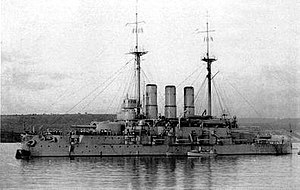
SMS Goeben was the second of two Moltke-class battlecruisers of the Imperial German Navy, launched in 1911 and named after the German Franco-Prussian War veteran General August Karl von Goeben. Along with her sister ship, Goeben was similar to the previous German battlecruiser design, Von der Tann, but larger, with increased armor protection and two more main guns in an additional turret. Goeben and Moltke were significantly larger and better armored than the comparable British Indefatigable class.

The Russian battleship Potemkin was a pre-dreadnought battleship built for the Imperial Russian Navy's Black Sea Fleet. She became famous during the Revolution of 1905, when her crew mutinied against their officers. This event later formed the basis for Sergei Eisenstein's 1925 silent film Battleship Potemkin.
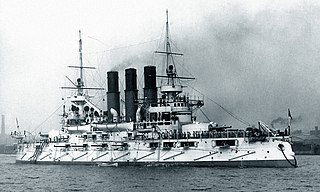
Retvizan was a pre-dreadnought battleship built before the Russo-Japanese War of 1904–1905 for the Imperial Russian Navy. She was built by the American William Cramp & Sons because Russian shipyards were already at full capacity. Named after a Swedish ship of the line that was captured during the battle of Vyborg Bay in 1790, Retvizan was briefly assigned to the Baltic Fleet, but was transferred to the Far East in 1902.

The Imperatritsa Mariya-class battleships were the first dreadnoughts built for the Black Sea Fleet of the Imperial Russian Navy. All three ships were built in Nikolayev during World War I; two of the ships were built by the Rossud Dockyard and the third was built by the Associated Factories and Shipyards of Nikolayev. Two ships were delivered in 1915 and saw some combat against ex-German warships that had been 'gifted' to the Ottoman Empire, but the third was not completed until 1917 and saw no combat due to the disorder in the navy after the February Revolution earlier that year.

Tsesarevich was a pre-dreadnought battleship of the Imperial Russian Navy, built in France at the end of the 19th century. The ship's design formed the basis of the Russian-built Borodino-class battleships. She was based at Port Arthur, northeast China, after entering service and fought in the Russo-Japanese War of 1904–1905. Tsesarevich was torpedoed during the surprise attack on Port Arthur and was repaired to become the flagship of Rear Admiral Wilgelm Vitgeft in the Battle of the Yellow Sea and was interned in Qingdao after the battle.

The Andrei Pervozvanny class were a pair of pre-dreadnought battleships built in the first decade of the twentieth century for the Baltic Fleet of the Imperial Russian Navy. They were conceived by the Naval Technical Committee in 1903 as an incremental development of the Borodino-class battleships with increased displacement and heavier secondary armament. The disastrous experiences of the Russo-Japanese War of 1904–1905 and the unrest resulting from the 1905 Russian Revolution led to countless redesigns, change orders and delays in construction. Despite the designers' repeated attempts to modernize the ships while under construction, they were obsolete in concept from the beginning, and even more so when they entered service in 1911.

Slava was a pre-dreadnought battleship of the Imperial Russian Navy, the last of the five Borodino-class battleships. Completed too late to participate in the Battle of Tsushima during the Russo-Japanese War, she survived while all of her sister ships were either sunk during the battle or surrendered to the Imperial Japanese Navy.

Gromoboi was an armoured cruiser built for the Imperial Russian Navy in the late 1890s. She was designed as a long-range commerce raider and served as such during the Russo-Japanese War of 1904–05. When the war broke out, she was based in Vladivostok and made several sorties in search of Japanese shipping in the conflict's early months without much success.
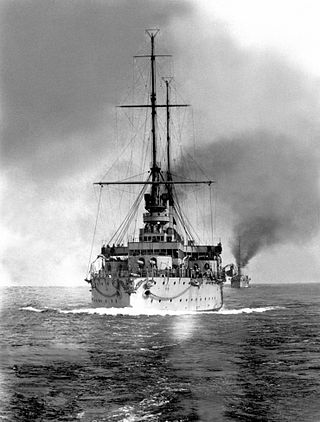
Rostislav was a pre-dreadnought battleship built by the Nikolaev Admiralty Shipyard in the 1890s for the Black Sea Fleet of the Imperial Russian Navy. She was conceived as a small, inexpensive coastal defence ship, but the Navy abandoned the concept in favor of a compact, seagoing battleship with a displacement of 8,880 long tons (9,020 t). Poor design and construction practices increased her actual displacement by more than 1,600 long tons (1,600 t). Rostislav became the world's first capital ship to burn fuel oil, rather than coal. Her combat ability was compromised by the use of 10-inch (254 mm) main guns instead of the de facto Russian standard of 12 inches (305 mm).

The Ekaterina II class were a class of four battleships built for the Imperial Russian Navy in the 1880s. They were the first battleships built for the Black Sea Fleet. Their design was highly unusual in having the main guns on three barbettes grouped in a triangle around a central armored redoubt, two side-by-side forward and one on the centerline aft. This was intended to maximize their firepower forward, both when operating in the narrow waters of the Bosphorus and when ramming. Construction was slow because they were the largest warships built until then in the Black Sea, and the shipyards had to be upgraded to handle them.

Navarin was a pre-dreadnought battleship built for the Imperial Russian Navy in the late 1880s and early 1890s. The ship was assigned to the Baltic Fleet and spent the early part of her career deployed in the Mediterranean and in the Far East. She participated in the suppression of the Boxer Rebellion in 1900 before returning to the Baltic Fleet in 1901. Several months after the beginning of the Russo-Japanese War in February 1904, she was assigned to the 2nd Pacific Squadron to relieve the Russian forces blockaded in Port Arthur. During the Battle of Tsushima in May 1905, she was sunk by Japanese destroyers which spread twenty-four linked mines across her path during the night. Navarin struck two of these mines and capsized with the loss of most of her crew.

Sissoi Veliky was a pre-dreadnought battleship built for the Imperial Russian Navy in the 1890s. The ship's construction was marred by organizational, logistical and engineering problems and dragged on for more than five years. She was commissioned in October 1896 with an appalling number of design and construction faults, and only a few of them were fixed during her lifetime. Immediately after sea trials, Sissoi Veliky sailed to the Mediterranean to enforce the naval blockade of Crete during the Greco-Turkish War. On March 15 [O.S. March 3], 1897 she suffered a devastating explosion of the aft gun turret that killed 21 men. After nine months in the docks of Toulon for repairs, the ship sailed to the Far East to reinforce the Russian presence there. In the summer of 1900, Sissoi Veliky supported the international campaign against the Boxer Rebellion in China. Sailors from Sissoi Veliky and the battleship Navarin participated in the defence of the International Legations in Beijing for more than two months.
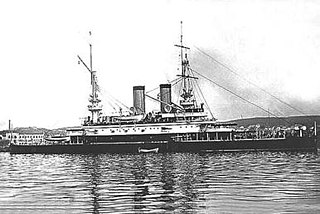
Tri Sviatitelia was a pre-dreadnought battleship built for the Imperial Russian Navy during the 1890s. She served with the Black Sea Fleet and was flagship of the forces pursuing the mutinous battleship Potemkin in June 1905. During World War I the ship encountered the German battlecruiser SMS Goeben twice, but never hit the German ship, nor was she damaged by her. From 1915 onward she was relegated to the coast bombardment role as she was the oldest battleship in the fleet. Tri Sviatitelia was refitting in Sevastopol when the February Revolution of 1917 began and she was never operational afterwards.
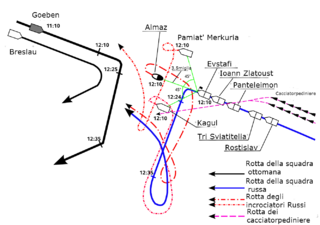
The Battle of Cape Sarych was a naval engagement fought off the coast of Cape Sarych in the Black Sea during the First World War. In November 1914, two modern Ottoman warships, specifically a light cruiser and a battlecruiser, engaged a Russian fleet including five obsolescent pre-dreadnought battleships in a short action.

Chesma was the second ship of the Ekaterina II-class battleships built for the Imperial Russian Navy in the 1880s. When the ship was completed she proved to be very overweight which meant that much of her waterline armor belt was submerged. Russian companies could not produce the most advanced armour and machinery desired by the Naval General Staff, so they were imported from the United Kingdom and Belgium. Chesma spent her career as part of the Black Sea Fleet.
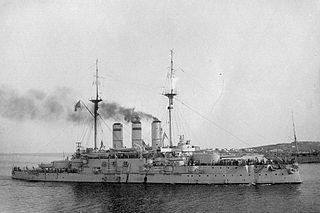
Evstafi was the lead ship of her class of two pre-dreadnought battleship of the Imperial Russian Navy's Black Sea Fleet. She was built before World War I and her completion was greatly delayed by changes made to reflect the lessons of the Russo-Japanese War of 1905.

Ioann Zlatoust was an Evstafi-class pre-dreadnought battleship of the Imperial Russian Navy's Black Sea Fleet. She was built before World War I and her completion was greatly delayed by changes made to reflect the lessons of the Russo-Japanese War of 1905. She was the second ship of her class.

Georgii Pobedonosets was a battleship built for the Imperial Russian Navy, the fourth and final ship of the Ekaterina II class. She was, however, only a half-sister to the others as her armor scheme was different and she was built much later than the earlier ships. She participated in the pursuit of the mutinous battleship Potemkin in June 1905, but her crew mutinied themselves. However, loyal crew members regained control of the ship the next day and they ran her aground when Potemkin threatened to fire on her if she left Odessa harbor. She was relegated to second-line duties in 1908. She fired on SMS Goeben during her bombardment of Sevastopol in 1914, but spent most of the war serving as a headquarters ship in Sevastopol. She was captured by both sides during the Russian Civil War, but ended up being towed to Bizerte by the fleeing White Russians where she was eventually scrapped.

Bayan was the third of the four Bayan-class armoured cruisers built for the Imperial Russian Navy in the early 1900s. The ship was assigned to the Baltic Fleet. She was modified to lay mines shortly after World War I began. Bayan laid mines herself and provided cover for other ships laying minefields. The ship fought several inconclusive battles with German ships during the war, including the Battle of Åland Islands in mid-1915. She also participated in the Battle of Moon Sound during the German invasion of the Estonian islands in late 1917, where she was damaged. Bayan was decommissioned in 1918 and sold for scrap in 1922.
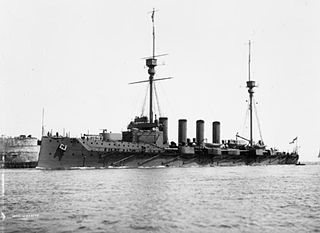
The Warrior class consisted of four armoured cruisers built for the Royal Navy in the first decade of the 20th century. After commissioning, all four sister ships were assigned to the Channel and Home Fleets until 1913 when Warrior was transferred to the Mediterranean Fleet. After the start of World War I in August 1914, Warrior participated in the pursuit of the German battlecruiser SMS Goeben and light cruiser SMS Breslau and her three sisters were assigned to the 2nd Cruiser Squadron of the Grand Fleet. Warrior joined the 1st Cruiser Squadron of the Grand Fleet in late 1914. Neither squadron participated in any of the naval battles in the North Sea in 1915. Natal was destroyed by a magazine explosion in late 1915 and only two of the ships participated in the Battle of Jutland in 1916. Cochrane was not engaged during the battle, but Warrior was heavily damaged and sank the following morning.
